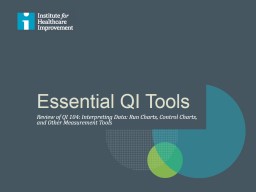

QI 104 Interpreting Data Run Charts Control Charts and Other Measurement Tools Lecture Objectives Draw a run chart that includes a baseline median a goal line and annotations Describe the difference between common and special cause variation ID: 1029716
Download Presentation The PPT/PDF document "Essential QI Tools Review of" is the property of its rightful owner. Permission is granted to download and print the materials on this web site for personal, non-commercial use only, and to display it on your personal computer provided you do not modify the materials and that you retain all copyright notices contained in the materials. By downloading content from our website, you accept the terms of this agreement.
1. Essential QI ToolsReview of QI 104: Interpreting Data: Run Charts, Control Charts, and Other Measurement Tools
2. Lecture ObjectivesDraw a run chart that includes a baseline median, a goal line, and annotations.Describe the difference between common and special cause variation.Explain the purpose of a Shewhart (or control) chart.Apply four rules to identify non-random patterns on a run chart.Explain when and how to use the following tools for understanding variation in data: histograms, Pareto charts, and scatter plots.
3. Lecture OutlineHow to display data on a run chartHow to learn from run charts and control chartsHistograms, Pareto charts, and scatter plots
4. Elements of a Run ChartAdd annotation hereBaseline MedianGoal Line
5. How many runs on this chart?Baseline Median
6. How many runs on this chart?Baseline Median5 runs
7. Interpreting VariationCommon Cause VariationSpecial Cause VariationInherent to the system or processNot inherent to the process designDue to regular, natural, or ordinary causesDue to irregular or unnatural causesAffects all the outcomes of a processAffects some but not necessarily all aspects of the processResults in a “stable” process that is predictableResults in an “unstable” process that is not predictableAlso known as random or unassignable variationAlso known as non-random or assignable variation
8. Signs of Special Cause VariationRule 1: Shift≥ 6 consecutive points above or below the medianRule 2: Trend≥ 5 consecutive points all increasing or decreasing
9. Signs of Special Cause VariationRule 3: Too many or too few runs Calculated with a mathematical equation based on the number of useful data pointsRule 4: Astronomical data point Data point that appears far away
10. Is there non-random variation here?
11. Is there non-random variation here?TrendAstronomical Point
12. Other Helpful ToolsShewhart chart: upper and lower control limitsHistogram: distribution of continuous dataPareto chart: relative frequency of occurrenceScatter plot: relationship between two data sets
13. Shewhart CartTime series chart showing control limits (+/- 3 sigma from the mean)
14. HistogramBar chart showing distribution of continuous data
15. Pareto ChartBar chart showing relative frequency
16. Scatter PlotGraph showing relationship between 2 data setsHours WorkedStaff Satisfaction
17. Videohttp://www.ihi.org/education/IHIOpenSchool/resources/Pages/Activities/Provost-HowDoVisualToolsHelpImprovement.aspx https://youtu.be/-NoE09oCdpw
18. DiscussionWhen embarking on health care improvement, why is it so important to see and appreciate the full complexity of a system?How have you used visual tools, such as run charts or flowcharts, to help with improvement? (If you haven’t used these tools, how do you think they could help you?)In the video, Provost talks about getting “bogged down” by overusing improvement tools. Why do you think he warns against this?http://www.ihi.org/education/IHIOpenSchool/resources/Documents/Facilitator_Provost-HowDoVisualToolsHelpImprovement.pdf
19. ExerciseGo to http://www.ihi.org/education/IHIOpenSchool/resources/Documents/QI104_exercise.pdf Follow to instructions and draw a run chart.Annotate any patterns you see.Ask a colleague to review your work, and refine your ideas based on the peer feedback.Discuss what you learned in this exercise.